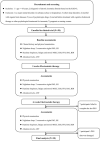Effects of electrostatic therapy on nighttime sleep and daytime symptoms in patients with chronic insomnia: Evidences from an open label study
- PMID: 36685220
- PMCID: PMC9853294
- DOI: 10.3389/fnins.2022.1047240
Effects of electrostatic therapy on nighttime sleep and daytime symptoms in patients with chronic insomnia: Evidences from an open label study
Abstract
Introduction: Transcranial electric stimulation (TES) is a neuromodulation approach that applies low-intensity electrical current to the brain and has been proposed as a treatment for insomnia. Electrostatic therapy is a kind of TES and people do not have a feeling of electrical stimuli when the voltage of static electricity is lower than 2,000 volts. However, no studies have examined the effects of electrostatic therapy on objective sleep and daytime symptoms in patients with insomnia.
Materials and methods: Thirty chronic insomnia patients were included. All patients received a 6 week electrostatic therapy and three comprehensive assessments including two consecutive polysomnography (PSG) and daytime symptoms assessments, at pre-treatment, 3 week and 6 week of treatment. Insomnia Severity Index (ISI) was used to assess the severity of insomnia. Multiple sleep latency test (MSLT), Epworth Sleepiness Scale (ESS), and Flinders Fatigue Scale (FFS) were used to assess objective and self-reported daytime sleepiness and fatigue, respectively. Attention network test (ANT) was used to assess attention levels.
Results: Total ISI scores decreased significantly at 3 weeks (p < 0.001) and 6 weeks (p < 0.001) after initiation of treatment. Furthermore, objective total sleep time (TST, p = 0.020) and sleep efficiency (SE, p = 0.009) increased and wake time after sleep onset (p = 0.012) decreased significantly after 6 weeks electrostatic therapy. Regarding daytime symptoms, ESS and FFS scores decreased significantly at 3 weeks (ESS, p = 0.047; FFS, p = 0.017) and 6 weeks (ESS, p = 0.008; FFS, p = 0.003) after initiation of treatment. Moreover, executive control improved significantly from pre-treatment to 3 weeks (p = 0.006) and 6 weeks (p = 0.013) and altering network improved significantly at 6 weeks (p = 0.003) after initiation of treatment. Secondary analyses showed that TST and SE improved significantly after electrostatic therapy in insomnia patients who slept < 390 min (all p-value < 0.05). However, no significant changes regarding TST and SE were observed in insomnia patients who slept ≥ 390 min.
Conclusion: Electrostatic therapy improves both nighttime sleep and daytime symptoms in patients with chronic insomnia. The effect on objective sleep appears to be stronger in patient with objective short sleep duration. Electrostatic therapy might be a therapeutic choice for insomnia patients with difficulty maintaining sleep and not responding to behavioral treatments.
Clinical trial registration: [www.clinicaltrials.gov], identifier [ChiCTR2100051590].
Keywords: electrostatic therapy; insomnia; insomnia with short sleep duration; transcranial electric stimulation; treatment.
Copyright © 2023 Dai, Qin, Chen, Chen, Sun, Vgontzas, Basta and Li.
Conflict of interest statement
The authors declare that the research was conducted in the absence of any commercial or financial relationships that could be construed as a potential conflict of interest.
Figures



Similar articles
-
A randomized controlled trial of cognitive behavioral therapy for insomnia and PAP for obstructive sleep apnea and comorbid insomnia: effects on nocturnal sleep and daytime performance.J Clin Sleep Med. 2022 Mar 1;18(3):789-800. doi: 10.5664/jcsm.9696. J Clin Sleep Med. 2022. PMID: 34648425 Free PMC article. Clinical Trial.
-
Effects of Adjunctive Brexpiprazole on Sleep Disturbances in Patients With Major Depressive Disorder: An Open-Label, Flexible-Dose, Exploratory Study.Prim Care Companion CNS Disord. 2016 Sep 8;18(5). doi: 10.4088/PCC.15m01914. Prim Care Companion CNS Disord. 2016. PMID: 27835722 Clinical Trial.
-
[Acupuncture at "umbilical four-acupoints" for chronic insomnia and its comorbid symptoms].Zhongguo Zhen Jiu. 2023 Jun 12;43(6):629-33. doi: 10.13703/j.0255-2930.20220815-0003. Zhongguo Zhen Jiu. 2023. PMID: 37313555 Clinical Trial. Chinese.
-
Issues in the diagnosis and treatment of insomnia.Psychopharmacology Suppl. 1984;1:11-43. doi: 10.1007/978-3-642-69659-6_2. Psychopharmacology Suppl. 1984. PMID: 6382252 Review.
-
The Future of Non-Invasive Brain Stimulation in Sleep Medicine.J Sleep Res. 2025 May 15:e70071. doi: 10.1111/jsr.70071. Online ahead of print. J Sleep Res. 2025. PMID: 40370279 Review.
Cited by
-
Whole-Body Electrostatic Pain Treatment in Adults with Chronic Pain: A Prospective Multicentric Observational Clinical Trial.Pain Ther. 2024 Feb;13(1):69-85. doi: 10.1007/s40122-023-00560-8. Epub 2023 Nov 28. Pain Ther. 2024. PMID: 38015366 Free PMC article.
References
-
- American Academy of Sleep (2014). International Classification of Sleep Disorders, 3rd Edn. Darien, IL: American Academy of Sleep Medicine. - PubMed
-
- Berry R., Quan S., Abreu A. (2020). The AASM Manual for the Scoring of Sleep and Associated Events: Rules, Terminology and Technical Specifications, Version 2.6. Darien, IL: American Academy of Sleep Medicine.
LinkOut - more resources
Full Text Sources

